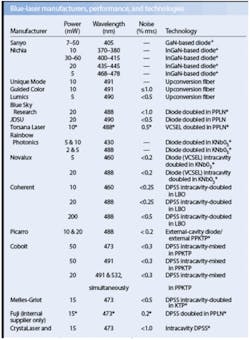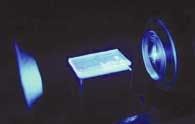Driven partly by the desire to replace aging ion laser technology and partly by market needs, many types of small blue-emitting solid-state lasers have been developed. These competing technologies are creating new paradigms.
The market for low-power blue-emitting lasers (powers of 20 mW and below) is benefiting from the rise of small solid-state lasers. These lasers come in many forms, including laser diodes, diode-pumped solid-state (DPSS) lasers, optically pumped semiconductors, vertical-cavity surface-emitting lasers (VCSELs), and upconversion fiber lasers (see table).
*Information is the author's opinion and has not been confirmed by the company; information should be verified directly with the company.
Based upon market requirements, the best technology for many applications would clearly be the gallium nitride-based laser diode, because it provides a clear long-term cost-reduction path. Also, such lasers can be directly modulated, which is of particular value in the graphics market. Unfortunately, laser diodes don’t meet other technical requirements just yet; visible blue-emitting diodes excel at around 400 nm but cannot currently compete beyond about 430 nm. The technologies can be ranked in order of likelihood of success simply by moving up the technology “food chain” from the diode to the directly doubled diode or upconversion fiber laser, and on to the DPSS laser.
Directly doubled diodes
A directly doubled diode is likely to be the winning technology for current low-power market needs. A 980-nm (actually 976 nm is used for the production of 488-nm light) telecom pump diode has all the required attributes demanded by the market, including mass production and packaging. The existence of several variants of engineered external doubling media-for example, stoichiometric lithium tantalate, magnesium oxide-doped periodically poled lithium niobate, and periodically poled potassium titanyl phosphate (KTP)-offer paths to shift the 980-nm pumps into the blue, thereby translating all of the advantages of the 980-nm diode source to the 488-nm blue laser.
Coherent (Santa Clara, CA) shouldn’t worry too much about these solutions encroaching on its high-power market segment, however. Lifetime at power has always been the bane of these engineered nonlinear optical materials, and lifetime problems are at their worst in the blue and generally catastrophic at blue power levels above 50 mW. There have been impressive demonstrations of high-power blue-light generation in bulk quasi-phase-matched media (for example, at Stanford University, Palo Alto, CA), but these require very high-power, narrow-linewidth (on the order of 0.2 nm to match the narrow grating resonance) 980-nm sources that are not cost-effective for blue.
To achieve the necessary conversion efficiencies at low power, a quasi-phase-matched material requires a waveguide, and this leads to most of the lifetime problems. In annealing-proton-exchanged or reverse-proton-exchanged waveguides, protons move and the efficiency decays. This is a real shame, because a waveguide chip can be pigtailed directly to a 980-nm pump, making a tiny, remote blue-laser head that generates no heat and can therefore be placed much closer to the work surface (see Fig. 1). Almost every doubling crystal requires tight temperature control, however, and most blue solid-state lasers are light-looped to maintain constant power (as are air-cooled argon-ion lasers), so some additional electronics would be required in the crystal location anyway.
Upconversion fiber lasers
Fiber lasers are also worthy of note because they potentially have the same cost benefits as directly doubling a 980-nm telecom pump laser. The fiber is coupled (unfortunately not simply spliced) to a pump laser (around 800 nm) and the fiber is generally coiled inside a compact package (see Fig. 2). The work on upconversion techniques in fibers has struggled since the 1980s and has been plagued with all kinds of higher-order nonlinear effects that generate a multitude of unwanted wavelengths and consequences (like fiber decay). However, at least two companies are launching such lasers this year. If one manufactures both the specialty fiber and the laser, it is possible to drive costs quite low (provided the manufacturing equipment was inherited); essentially the fiber is spliced to a fiber-coupled diode pump, so that the economics are largely the same as for a doubled diode. There are concerns about stability (upconversion lasers are quite noisy) and lifetime for these products, but at lower power levels these will likely be resolved.
Intracavity-doubled diodes
Intracavity-doubled diodes are another strong contender. While not as cost-effective as a simple externally doubled diode, they do overcome the waveguide problems of external doublers. During the telecom bubble several companies began manufacturing VCSELs, and with external cavities VCSELs can be efficiently intracavity doubled. VCSELs do not like to lase in a single polarization, so intracavity doubling is challenging, as is wavelength and longitudinal-mode stability. However, multimirror cavities and appropriate stress and current injection can help solve these problems. Quasi-phase-matched materials can also perform well in this application, because it does not require a waveguide.
The long-term concern with these types of lasers, however, is the lack of a viable manufacturing platform. While the standard 980-nm pumps roll off a high-volume telecom line and can be directly doubled to blue, VCSELs have no such high-volume market. It is not economically feasible to run an entire fabrication facility just to produce a single wafer to serve a year’s production of VCSELs for blue lasers. Further, removal of the output-coupling mirror from the VCSEL substrate also removes much of the economic benefit of wafer-scale production. On the plus side, the intracavity VCSEL approach offers a wide range of output wavelengths on a common manufacturing platform. If the VCSEL solution can either be outsourced or amortized over a wider range of products (for example, with a recovery of the telecom market), then this technology will be a strong play.
Diode-pumped solid-state lasers
While not offering the cost-competitiveness of doubled diodes that is essential for the low-power niche, DPSS lasers provide a clear power-scaling path to attack the high-power region. These include intracavity-doubled Nd:YVO4 (vanadate) lasers, optically pumped semiconductors, and 946-nm Nd:YAG lasers. The doubling media required for blue include lithium triborate (LBO), potassium niobate (KNbO3), KTP, and quasi-phase-matched variants of the same (that is, periodically poled). The quasi-phase-matched materials have very narrow acceptance bandwidths of about 0.2 nm; however, the stability requirements of the blue source require either single-frequency operation or operation near coherence collapse anyway.
It is not easy to produce continuous-wave blue light without an intracavity-doubling technique unless there is access to the very high nonlinear drive afforded by quasi-phase-matched materials. Intracavity-doubled lasers present extreme challenges for stability, mode quality, and reliability, while the quasi-phase-matched materials have some unique problems, including short lifetime. Conventional materials like KNbO3 offer their own lifetime challenges with stress- or temperature-induced depoling, although new variants on this old material appear to have helped overcome these limitations. The best DPSS solutions appear to be intracavity-doubled lasers using LBO or periodically poled KTP doublers. One such product produces two near-ion-laser wavelengths simultaneously using a dual-grating periodically poled KTP chip (see Fig. 3). The technology offering the highest power-scaling potential is undoubtedly the optically pumped semiconductor, as evidenced by Coherent’s impressive 20-W blue result demonstrated at Photonics West earlier this year.
Looking forward
In 1996 a new solid-state green-laser technology allowed Iridex (Mountain View, CA) to move forward with an initial public offering and it is possible that one of the emerging blue-laser companies could do the same thing in the 2000s. Within two years, there will likely be only one stand-alone new competitor with a $20 million run rate, and (hopefully) two acquisitions by the entrenched players. The winner here will need to take ownership of a new application enabled by these new solid-state blue lasers, thereby expanding the overall market rather than cannibalizing the existing ion-laser business. Wouldn’t it be wonderful to use a new technology to make the pie bigger for everyone?
LARRY MARSHALL is a serial entrepreneur with six successful startups in the photonics business. He is based in Silicon Valley, CA; e-mail: [email protected].



